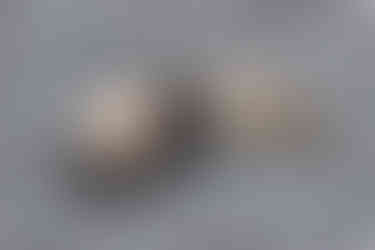
After leaving the Falkland Islands, it took two-and-a-half days at sea to arrive at South Georgia, which we explored for five days. Fortunately, the seas were relatively calm (the Fram is not a large ship, so it definitely pitches and rolls). Seasickness wrist bands and meclizine pills kept Doug's stomach calmed.
South Georgia's story is one of ecological recovery. In the early 20th Century, it was one of the largest whale rendering locations on earth. There are no trees on South Georgia, and the heat needed to melt whale blubber came from captured king penguins (which have a high oil content in their flesh) who were thrown into the furnaces and used as kindling, reducing their count from millions to just 1,000 at their low point. Seals of many different varieties were hunted for their skins.
Whaling and seal hunting both ended in the 1960s. Non-native reindeer were successfully eradicated in the 1990s, and the island was finally declared rodent-free in 2016. These measures together have allowed the penguins, seals, and seabirds to return in force in recent years.

We arrived at South Georgia on Sunday, February 26, in time for an afternoon landing at Right Whale Harbor, home of a colony of king penguins.

The young born this season were now almost as tall as their parents, and were in the process of losing their brown coats. The only penguins larger than kings are emperor penguins, who only live on Antarctica and whose colonies are some miles inland. We are very unlikely to see them on this trip.

Each time we went ashore, the crew needed to bring enough emergency supplies to keep us safe and fed for up to 24 hours in case the wind and seas did not allow us to return to the Fram. There are sleeping bags, shelters, space blankets, food, water and, most importantly, toilet paper.

Our landing spot was a beautiful long black beach, filled with king penguins and also with fur seal pups and their mothers.

Seal pups can range in color from almost black to a blond color. We saw a few pups suckling from their mothers.
King penguins, with their beautiful coats and orange and yellow coloring, waddled around, pretty much ignoring the "red penguins" wandering among them.
One penguin was practicing his aerobic exercises!
The South Georgia landscape is beautiful and dramatic, and would be worth visiting even if there was no wildlife.

The penguin colony continued up the hillside beyond the beach.

As we waited to board our zodiac to return to the ship, a whole group of king penguins gathered to see us off.

On Sunday morning, our plan to take small boat tours to see some macaroni penguins nesting on cliffs was cancelled due to high winds. Fortunately, the weather calmed down in the afternoon as we approached Salisbury Plain, where almost 150,000 king penguins live between the feet of two glaciers coming down from the highlands. The breathtaking terrain reminded us of both Alaska and Iceland.

There is a regular routine for coming ashore in the surf, and crew members were there to help us off the zodiacs.
Before proceeding beyond the beach, we always had an instructional briefing from Maria, a Norwegian who heads up the Fram's expedition team.
Below are a just a few of hundreds of pictures that we took of penguins, penguins, and more penguins. Be thankful that we're parsimonious in our photo sharing!!


After hiking about a mile we approached the main part of the colony, which extended along the beach and up the hillside behind it. Some curious king penguins came close to check us out.

On the walk back to the landing spot, Jeannette was followed by a very curious fur seal pup.

We continued our exploration of the South Georgian coast. On Tuesday morning, we finally were able to take small boat tours to see macaroni penguins, this time in Hercules Bay. The macaronis are on the small side (but bigger than the similar-looking rockhoppers that we saw in the Falklands), and have these huge yellow eyebrows you can see from far away.
In the afternoon, we landed at the old whaling staton of Grytviken (one of five whaling stations that had been scattered around South Georgia, and the only one you can wander around).
This stop is mandatory when you visit South Georgia, and local authorities inspected the ship, our biosafety procedures, and even the ship's lifeboats.

Our first stop onshore was at the grave of Sir Ernest Shackleton.

If you do not know Shackleton's story, it is one of the most heroic of modern times. His plan to cross the Antarctic continent was scuttled when his ship, the Endurance, was stuck in the ice, then crushed and ultimately sunk. His men wintered on the ice, then sailed the ship's three lifeboats to Elephant Island. Shackleton and five crew members then sailed 800 miles to South Georgia navigating with only a sextant on a voyage that lasted almost two weeks. Managing to reach shore on the western side of the island, Shackleton and two others came over the top of the mountainous island in an epic 36 hour hike to get to the Stromness whaling station on the eastern side. After four attempts, he managed to mount a rescue mission to Elephant Island a month or so later. Every single member of his original expedition team survived.
Shackleton made a return to South Georgia several years later as part of another Antarctic exploration mission, but died of a heart attack at Grytviken. His wife requested he be buried in South Georgia. We had to hike carefully past some giant elephant seals on the walk up to the graveyard.

We took a tour of the station site, including a small church where Shackleton's body lay before it was buried.
The whaling station was active from about 1910-1960, and was run primarily by Norwegians. For sport, they constructed not only a soccer field, but also a ski jump! In the last couple of decades, there has been a big effort by the South Georgia Heritage Trust to stabilize the buildings and remove asbestos so they are safe to visit. One of the buildings has been converted to a gift shop and post office (we declined to mail postcards) and another to a small but interesting museum.




After a guided walking tour of the whaling works, we were greeted by a dramatic rainbow as we prepared to returned to the ship.


As we continued along the coast, we marveled anew at the South Georgia scenery.

On Wednesday, we started the morning in Fortuna Bay, where we hiked to see a smaller (but still impressive) king penguin colony. Rain the night before had left the hillsides covered with a light dusting of snow.

We passed a family of fur seals. You can see the size difference between the male, the female, and the pups.

After about a kilometer's hike, we reached the king penguin colony.

In the afternoon, we arrived at Stromness whaling station. As in each landing session, we continued with boot inspections before we were permitted ashore to ensure that we did not transport errant grass seeds or other plant life between landing zones.

We could not get any closer than this to Stromness whaling station. The buildings have not been stabilized nor cleared of asbestos.

We started a hike to a waterfall, but it was tough going as we had to hike along a creekbed full of loose rocks. Doug managed to get close enough to snap a photo of the waterfall in the distance, but turned back before reaching it.


That evening, the ship's captain gathered us in the lecture hall and showed us this map of the wind forecast for the next day, centered on our location (the purpler the badder...).

He told us that in order to stay ahead of a gathering storm, we would have to cancel our last day's landings in South Georgia and start our voyage south to Antarctica. Even with an early departure, the seas were likely to be a bit rough.
We left South Georgia that evening for two days at sea. The next day, these started appearing...
...which made us even more excited for the final leg of our trip! More about that in our next blog post.



























































Comments